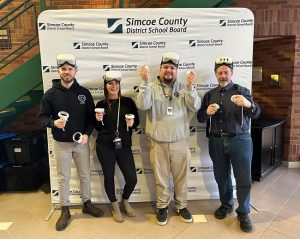There are almost 7,000 languages spoken in the world today, but just six or seven of them are used by most of us.
Many global languages – as many as forty per cent – are endangered species and they will soon be lost for good without preservation or protection of some kind. In many cases, it’s not just language, but culture, history, learning and accumulated wisdom that are at risk.
As is a way to reconcile the different truths that different communities experience.
The most vulnerable languages are Indigenous languages, many of which exist in purely oral form. There are some 70 Indigenous languages in Canada, but several have fewer than 1,000 fluent speakers.

Learning about Indigenous language and culture means donning virtual reality (VR) headsets and using other immersive learning technologies as part of new school curricula developed by Georgian College in Ontario.
The Simcoe County District School Board (SCDSB) and the Saskatchewan Indian Institute of Technologies have allied themselves with Georgian so that their elementary, secondary, and post-secondary students can make use of the VR headsets to visit VR worlds. They were created at the College to emphasize and reinforce not only a student’s comprehension and speaking skills but also provide a space for socialization.
From left: Simcoe County District School Board Ojibwe language teachers Brent Roy, Laurie Smith, and Jake King received virtual-reality training from Rob Theriault, Immersive Technology Manager at Georgian College. – Photo supplied
So artificial intelligence (AI), virtual reality (VR), and other online and digital tools are being used by companies and individuals to preserve and protect Indigenous languages here in Canada and around the world.
AI-powered machine translation is one of the primary tools being used. By teaching or training AI systems on huge datasets of different languages and an assembled library of common words, accepted meanings, and contextual information, the systems can “learn” a language and automatically translate text from one to another.
The data is gathered in part from existing books, articles, or other text, often publicly available on the Internet or assembled in more proprietary, specialty configurations. Of course, the quality of the training data has a huge impact on the effectiveness of AI and machine learning algorithms. So human intervention, tutoring, and corrective input from real people should all be a big part of machine learning and artificial intelligence.
Typically, AI developers need an enormous dataset of text sources and written transcripts for AI to understand a language’s spoken form. But many Indigenous languages and oral traditions do not have a consistent writing system, so AI for language translation training also involves “listening” as a person talks, studying the acoustic waveforms the sound of their sampled speech makes, and classifying the parts of speech accordingly. Waveforms can be words to a computer.
(Speaking of which: Well before AI came onto the scene, renowned Aboriginal scholar and storyteller Louis Bird was making audio recordings of the oral traditions and stories told by tribal Cree elders about traditional legends, teachings and traditions. Bird began recording the stories back in 1965; he led the way in such work and his collection totals more than 340 hours of aboriginal audio recordings. Much of his work found its way online as part of the OurVoices.ca website initiative, but sadly, following a cybersecurity breech at the University of Winnipeg earlier this year, that original resource is gone. Other sources and assets are still available, and important work on Indigenous language preservation continues in other venues and with other platforms.)
For example, a recently-announced project to revolutionize the preservation and revitalization of Indigenous languages using advanced AI technology.

Seeing Red Media works with media, technology, and AI to preserve and strengthen Indigenous languages.
Seeing Red Media, an Indigenous-owned media company based on Six Nations of the Grand River in Ontario, has partnered with Camb.ai, a global AI company, to develop leading-edge Native Indigenous language and speech models. The partnership is part of Seeing Red Media’s mission to promote Indigenous culture to a broader audience and marks a big step towards preserving and strengthening Indigenous languages.
Camb.ai has released proprietary text-to-speech tools for translation and voice cloning, built by a technical team with backgrounds at Carnegie Mellon, Apple, and Amazon, and published through Interspeech, an organization and industry conference about the science and technology of spoken language.
Its commercial products offer on-the-fly colloquial and contextual translations, and earlier this year, Camb.ai delivered live professional soccer commentary dubbed into four languages that were broadcast simultaneously, each maintain the native speaker’s voice and tone. The AI technology let broadcasters deliver live match coverage in multiple languages simultaneously. (By the way, Camb.ai has also partnered with Maple Leaf Sports & Entertainment, among other clients.)
Meanwhile, a local broadcaster and media outlet in New Zealand is working to preserve the Māori people’s language, known as te reo, with AI. The broadcaster is developing automatic speech recognition (ASR) models for the Indigenous language, describing it as a way to transparently collect speech data while protecting data sovereignty for the Māori people.
Built using the open source, dedicated ASR NeMo toolkit and A100 Tensor Core GPUs from Nvidia, the speech-to-text models transcribe translation with a very high (92 per cent reported) degree of accuracy and fidelity.
Developments such as these would not surprise the authors of a recent academic paper about translation and technology, titled The Impact of Artificial Intelligence on Language Translation: A Review.
Yes, translation is a challenging undertaking in which translators must possess a solid understanding of the linguistic intricacies in both overt and covert aspects of language. The authors point out that the translation process between any two languages presents several challenges, including vocabulary, syntax, phonetics, style, and other linguistic-related nuances.
So they see AI at the forefront of this transformative moment. Translation accuracy has reached new translation heights, they say, due to improved technological capabilities in understanding context, subtleties, and idiomatic expressions.
Looking ahead, they say promising opportunities lie in the convergence of AI and multi-modal translation, that works with both picture and voice recognition, as a techno-mediated way to support more inclusive communication and broader understanding among people of many languages.
-30-



